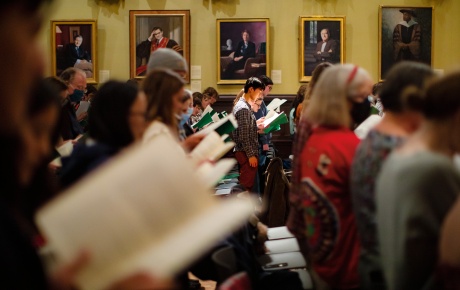
Rights + Wrong
No one’s pro-domestic-violence. Until you start looking at state laws, where protecting victims often loses out to protecting gun rights.
“Everybody’s against domestic violence,” says Brown political science professor Wendy Schiller. “Nobody wants to see children or women abused by a partner...so why would state legislators vote against [domestic violence laws]?” In their 2023 book, Inequality Across State Lines, Schiller and Kaitlin Sidorsky ’12 AM, ’15 PhD, now an associate professor at Ramapo College in New Jersey, take on what Schiller calls a “political puzzle that nobody tried to answer.” Their new book about how states make and enforce laws on domestic violence plumbs granular data from all 50 states on statutes governing domestic violence and guns and how consistently they’re enforced (spoiler alert: not very). Their goal, broadly stated on the book’s cover, is to explain “how policymakers have failed domestic violence victims in the United States.”
Often, they found, complex questions about why legislators vote against victims leads back to the same answer: guns.
The nearly three decades since the original Violence Against Women Act was passed has seen a growing understanding of, and concern over, domestic violence. Americans have come to a broad consensus that domestic violence is not a private matter but a criminal justice concern. But there’s also been a countertrend during those years: the rise of an uncompromising interpretation of the 2nd Amendment. Studies show that the most effective policies to address domestic violence center on getting guns away from abusers—but in some places this is an increasingly hard sell. So you can’t talk about addressing domestic violence without talking about the country’s gun culture.
“We could document over time how conservative Republican–controlled legislatures with more conservative populations decrease the likelihood of passing these laws that save lives, because [the laws] have gun restrictions,” Schiller says. “This isn’t just sort of anecdotal here and there, this is across the whole country. It’s not just interest-group influence, it’s really this coalescence of the Republican Party and the NRA.”
The book’s wide scope—achieved with the help of a team of student researchers, mostly undergrads—evaluates factors such as who is elected to make and enforce laws, how local laws often have a larger impact on victims’ experiences than federal policies, and the particular experiences of women of color, immigrants, and Indigenous women.
And it reaches the disturbing conclusion that, while the Violence Against Women Act of 1994 established domestic violence as a crime nationally, protections vary widely depending upon something as simple as where the victims and their abusers live.
“This isn’t just sort of anecdotal here and there, this is across the whole country. It’s not just interest-group influence, it’s really this coalescence of the Republican Party and the NRA.”
Determining which states are safer overall is harder than you’d think. For example, do victims of domestic violence have better legal protections in the progressive Northeast or in the conservative deep South? Once, Schiller and Sidorsky would have put their money on a state like Massachusetts having more effective laws to protect women than, say, Louisiana. When it comes to at least some significant measures, they discovered, they would have lost that bet.
Take Massachusetts and Louisiana. Schiller and Sidorsky note in an interview that Louisiana has some muscular domestic violence laws in place and those who are convicted there face tough sentences—in line with the state’s status as one of the nation’s leaders in incarceration in general. Massachusetts is more lenient and doesn’t jail people—including domestic abusers—for as long.
“That surprised us,” Schiller says. “You’d think the liberal states will be better for women, and in some cases they’re not because they’re not strict enough. They’ll give people bail, they’ll let people out on their own recognizance. They may have stronger gun laws in some ways, but they don’t punish domestic violence as assault.”
Massachusetts has improved in recent years, Schiller says, “but it was pretty bad for a long time.” She cites the combination of liberal politics and the often patriarchal views found in a legislature historically dominated by Irish Catholic men. “As the legislature has changed, with more women and more people of color,” she says, “that’s broken the hold, but it was really kind of a weird finding for us.”
Not that places that are more prone to lock abusers up don’t have their own shortcomings, including some enforcement practices that can actually discourage victims from seeking help at all.
In conservative states and some large cities elsewhere, particularly those with high nonwhite populations and histories of systemic racism, police are more likely to arrive at a scene and arrest both parties. Too often in these places, Sidorsky says, officers responding to calls for domestic violence incidents “don’t discern as much between victim and offender,” so women have good reason to believe that calling the police might make their situation worse.
“They don’t want to be arrested, and maybe they don’t want their partner arrested, just out of the house,” Sidorsky explains.
Safety is local
For Schiller and Sidorsky, who started their ongoing research nearly a decade ago amid the beginnings of the #MeToo movement, their overall aim is to better understand an overarching problem that affects an estimated 10 million Americans per year.

The stakes, as they write in their introduction, couldn’t be higher: “Human security is the foundation of a civil society,” they assert. “Women who are not assured safety in their own homes and private lives will never achieve the equality they deserve.”
In disciplines such as sociology, criminology, and public health, domestic violence research focuses on predicting who is most likely to become a victim and strategies to help. Schiller and Sidorsky set out to add a new dimension. The hole in the understanding, the authors say, was the institutional perspective.
“Political science and public policy have not really asked where the policies come from,” Sidorsky says. “Who makes them? What about the ones that have failed, and why they have failed, and why have some states adopted them versus states that have not adopted them? A sociologist or criminologist may tell us that having a firearm law is going to save lives, but no one tells us why one state passes one and why others won’t. How close do they get and where does it fail? And that says a lot about the politics of the state and how it treats women generally.”
The project grew out of the authors’ longstanding research into the status of women at different levels of government and how growing representation translates into policy change. Schiller has studied Congress and how institutions function. Sidorsky has focused on female advocacy and representation; her Brown dissertation looked at women who serve on the boards and commissions that have a huge influence on people’s daily lives. The subject of domestic violence is personal to her: her mother and grandmother were victims, at the hands of her police officer grandfather.
Those perspectives led them to zero in on what happens not so much in the halls of Congress but where the rubber meets the road in statehouses, city halls, courtrooms, and police and sheriff’s departments.
“We have sovereign power at the federal level and sovereign power at the state level,” Schiller explains. “Congress can pass a law but then if it’s not properly implemented by the states, it doesn’t do as much good.”
One measure of the disparity in the way states handle domestic violence is documented in one of the book’s many charts, showing which states have adopted each of eight categories of domestic violence firearm laws, including whether convicted stalkers, dating partners convicted of misdemeanors, and those subject to a domestic violence restraining order are banned from buying or possessing guns. Despite the aforementioned deficiencies in its protections, Massachusetts has adopted all eight, and Louisiana five. There are some surprises here in this data too: conservative Texas has seven of the eight, while political swing state Georgia doesn’t have any of them.
“Human security is the foundation of a civil society. Women who are not assured safety in their own homes and private lives will never achieve the equality they deserve.”
But even these all-important gun laws are just part of the story, the authors point out. Enforcement can vary county by county, they say, and courtroom to courtroom. So far they haven’t found a judge’s ideology to predict how laws are interpreted at the individual case level (examining whether district attorneys’ ideologies play a role is a future tentacle of the project). Gender does appear to matter, though, in that female judges are more likely to remove a firearm in a domestic violence case than a male judge. And of course, taking guns away from people with restraining orders only works if officials in the jurisdiction are granting restraining orders in the first place.
Follow the (grant) money
The untangling of all these different variables has been a big challenge because a data set, particularly such a sprawling one, is only as useful as what goes into it.
That’s where the project has emerged as a valuable teaching tool. Student research assistants say it has shaped both their understanding of policy and their career aspirations. Three former researchers—Gianna Jasinski ’18, Rakhi Kundra ’21, and Cayla Kaplan ’20—are now law students, while Kamaile Patton ’22 AM is working at a nonprofit focused on combating gender-based violence. Schiller credits them with contributing not just leg work, but some of the key ideas that helped shape the book, as well as training the next group of researchers.
That new team is helping Schiller and Sidorsky with their most recent research: surveying judges’ attitudes and backgrounds and following the trail of the half billion a year in federal grant money to combat domestic violence, distributed through 25 programs. Schiller says they hope to get to the question of federal effectiveness, who applies for this money, and what they’re doing with it.
Their bigger idea is to paint a fuller picture of the ways state and local policies still stack the deck against women on everything from wages, child care, and divorce and custody arrangements to educational opportunities and tax structures. “These are all areas where state laws render women more empowered or less, and there’s inequality, pervasive across the country,” Schiller says. “So it’s the same fruit.”
Stephanie Grace ’87 is a political columnist at the New Orleans Times-Picayune and the Baton Rouge Advocate, and a BAM contributing editor. She lives in New Orleans.




